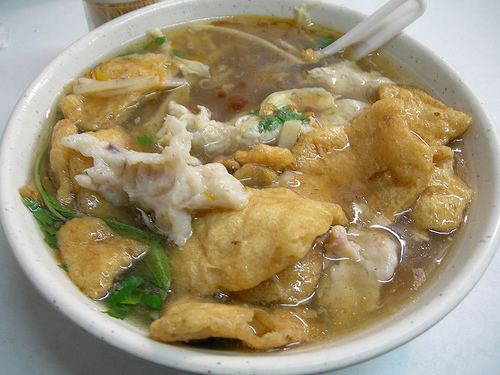Chinese 福建菜 Hokkien POJ Hok-kiàn chhài Simplified Chinese 闽菜 | Hanyu Pinyin Traditional Chinese 閩菜 Hanyu Pinyin | |
 | ||
Fujian cuisine is one of the native Chinese cuisines derived from the native cooking style of Fujian province in China, most notably from the Fuzhou region. Fujian-style cuisine is known to be light but flavourful, soft, and tender, with particular emphasis on umami taste, known in Chinese cooking as "xianwei" (simplified Chinese: 鲜味; traditional Chinese: 鮮味; pinyin: xiānwèi), as well as retaining the original flavour of the main ingredients instead of masking them.
Contents
Many diverse seafoods and woodland delicacies are used, including a myriad variety of local fish, shellfish and turtles, or indigenous edible mushrooms and bamboo shoots, provided by the coastal and mountainous regions of Fujian. The most commonly employed cooking techniques in the region's cuisine include braising, stewing, steaming and boiling.
Particular attention is paid on the finesse of knife skills and cooking technique of the chefs, which is used to enhance the flavour, aroma and texture of seafood and other foods. Strong emphasis is put on the making and utilising of broth and soups. There are sayings in the region's cuisine: "One broth can be changed into numerous (ten) forms" (simplified Chinese: 一汤十变; traditional Chinese: -湯十變; pinyin: yī tāng shí biàn) and "It is unacceptable for a meal to not have soup" (simplified Chinese: 不汤不行; traditional Chinese: 不湯不行; pinyin: bù tāng bù xíng).
Fermented fish sauce, known locally as "shrimp oil" (simplified Chinese: 虾油; traditional Chinese: 蝦油; pinyin: xiā yóu), is also commonly used in the cuisine, along with oysters, crab, and prawns. Peanuts (utilised for both savoury dishes and desserts) are also prevalent, and can be boiled, fried, roasted, crushed, ground or even turned into a paste. Peanuts can be used as a garnish, feature in soups and even be added to braised or stir-fried dishes.
Styles
Fujian cuisine consists of four styles:
Seasonings
Unique seasoning from Fujian include fish sauce, shrimp paste, sugar, Shacha sauce, and preserved apricot. As well, wine lees from the production of rice wine is commonly used in all aspects of the region's cuisine. Red yeast rice (simplified Chinese: 红麴 / 红糟酱; traditional Chinese: 紅麴 / 紅糟醬; pinyin: hóngqū / hóngzāojiàng) is also commonly used in Fujian cuisine, imparting a rosy-red hue to the foods, pleasant aroma, and slightly sweet taste
Fujian is also well known for its "drunken" (wine marinated) dishes and is famous for the quality of the soup stocks and bases used to flavour their dishes, soups, and stews.
Notable dishes
One of the most famous dishes in Fujian cuisine is "Buddha Jumps Over the Wall", a complex dish making use of many ingredients, including shark's fin, sea cucumber, abalone, and Shaoxing wine.
Fujian is also notable for yanpi (Chinese: 燕皮; pinyin: yànpí), literally "swallow skin," a thin wrapper made with large proportions of lean minced pork. This wrapper has a unique texture due to the incorporation of meat and has a "bite" similar to things made with surimi. Yanpi is used to make rouyan (Chinese: 肉燕; pinyin: ròuyàn), a type of wonton.
There are many eating places around the province that sell these specialities for two yuan, and which are thus known as "two-yuan eateries". In Xiamen, a local speciality is worm jelly (t 土笋凍, s 土笋冻, tǔsǔndòng), an aspic made from a species of marine peanut worm.
